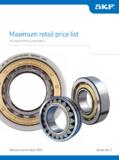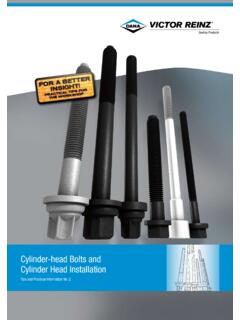Transcription of API 682 Most common Plans and Sealing Systems
1 API 682 most common Plans and Sealing SystemsPlan 53 BPlan 53 CPlan 52 Used where the pumped product is harmful / hazardous and / or buffer fluid may not contaminate the product. External reservoir at pressure below seal chamber pressure providing buffer liquid forced for applications where products have high pressure and are harmful/hazardous. Pre-pressurized bladder accumulator provides pressure to circulation system . Heat removed by air/water heat exchanger. Forced for applications where products have high pressure and are harmful/hazardous. Pressurization by reference line from seal chamber to a piston pressure booster provides pressurized barrier fluid to circulation system . Forced general applications. Product pumped clean, good lubricating properties and heat removal from the mechanical seal. Recirculation from pump discharge through flow control orifice to the 11 Used in applications with suspended solids where the SG of the particles are 2x that of the liquid.
2 Recirculation from pump discharge through a cyclone separator, clean fluid to seal chamber, contaminated fluid to 31 Used for hot liquid applications or where the temperature and pressure in the seal chamber is close to the vapour curve of the by means of a pumping ring in seal chamber through a cooler and back to seal chamber cooling or heating and neck bush are necessary, unless otherwise specified. Dead end seal chamber with no circulation. Plugged connections for possible future circulation and when the product being pumped does not have good lubrication properties, is dirty or hazardous. Flush injecton of clean fluid into the seal chamber from an external 32 Used for hot applications or where the temperature and pressure in the seal chamber is close to the vapour curve of the product. Recirculation from pump discharge through a flow control orifice and cooler into the seal 21 (22) plan 02 Application where pump fluid does not condense at ambient temperature.
3 Containment seal chamber drain for non-condensing 76 plan 74 AApplication when pump fluid condenses at ambient temperatures. Containment seal chamber drain for condensing 72 ABCPlan 75 APlan 13 plan 54to drainPlan 53 AAto flareUsed in applications where the product is harmful/hazardous. Externally supplied barrier gas used to positively prevent process fluid from leaking to with hydrocarbons, normally used in conjunction with plan 75 or plan 76. Externally supplied gas buffer (pressure lower than seal pressure). Buffer gas used to dilute seal to plan 75 Aconnect to plan 76BN2CN2 ADevice to be located below pump shaftAUsed for hot applications or where products have low pressure and are harmful/hazardous. External reservoir pressurized above seal chamber pressure providing barrier fluid to mechanical seals. Forced where the seal chamber pressure is at discharge pressure (mainly vertical pumps).
4 Recirculation from pump seal chamber through a flow control orifice and back to the to keep atmospheric side of seal clean. External source providing a flow-through quench to atmospheric 62 Used in harmful/hazardous applications. Pressurized clean barrier fluid from an external system . Fluid circulation by an external pump or pressure to be located below pump shaftAUsed for leakage detection on single seal. Atmospheric side leakage collection and monitoring in external 65 Ato drainProcess sideBetween sealsAtmospheric sidePlan 23 The API 682 has emerged to become a worldwide accepted standard in today`s refinery and hydrocarbon related applications. EagleBurgmann offers a wide range of high quality mechanical seals and supply Systems which fully comply with API 682. From expert consulting and engineering up to modular TotalSealCare service solutions for entire plants EagleBurgmann is your reliable partner for Sealing technology.
5 Please ask also for our detailed brochure 58E, our API 682 seal selection software on CD or find your nearest contact at reverse side of this poster for API seal plan functionsLeakage alarm and collectionBuffer Systems (psealchamb > pbetweenseals)Barrier Systems (psealchamb < pbetweenseals)Flushing and cooling Media characteristicsSuspended solidsPoor lubricationHigh temperatureHazardous / harmfulLeakage may form solidsClose to vapourisation point* Only in combination with additional API planto flareAPIPSTE / E1 / / / EagleBurgmann Marketing Communications Germany** Default OptionalconfigurationsconfigurationsCate goryCategory 1 Category 2 Category 3 ISO 3069 type C, ASME , ASME 13709 / API 610 10th edition-40 C .. 260 C, 21 bar g (-40 F .. 500 F, 300 PSI)-40 C .. 400 C, 41 bar g (-40 F .. 750 F, 600 PSI)Minimal data requirementsRigorous data requirementsArrangementsConfigurationsAr rangement 11CW-FXSingle seal cartridgeContacting Wet - FiXed throttle bushing1CW-FLContacting Wet - FLoating throttle bushingArrangement 22CW-CWDual seal cartridge- pressure between seals less than seal chamber pressure- internal reverse balance featureContacting Wet - Contacting Wet2CW-CSContacting Wet - Containment Seal 2NC-CSNon-Contacting - Containment Seal Arrangement 33CW-FBDual seal cartridge- pressure between seals higher than seal chamber pressure - internal reverse balance featureContacting Wet - Face-to-Back3CW-BBContacting Wet - Back-to-Back3CW-FFContacting Wet - Face-to-Face3NC-BBNon-Contacting - Back-to-Back3NC-FFNon-Contacting - Face-to-Face3NC-FBNon-Contacting - Face-to-BackTypesType APusher sealTemperature: -40.
6 176 C (-40 .. 350 F), pressure: 41 bar g (600 PSI) Type BMetal bellows seal with O-ringsTemperature: -40 .. 176 C (-40 .. 350 F), pressure: 21 bar g (300 PSI) Type CMetal bellows seal with flexible graphiteTemperature: -40 .. 400 C (-40 .. 750 F), pressure: 21 bar g (300 PSI)Type ESTotally Engineered Sealing system for service conditions outside the operating limits of type A, B and CSeal Code according to API 682 3rd editionExampleCategoryArrangementTypeAPI plan (s)C2A3A1153 ACategory 1 = C1 Category 2 = C2 Category 3 = C3 Arrangement 1 = A1 Arrangement 2 = A2 Arrangement 3 = A3 Type A = AType B = BType C = CAPI Plans : 02, 11, 13, 21(22), 23, 31, 32, 52, 53A, 53B, 53C, 54, 62, 65, 72, 74, 75, 76 Explanation of example C2A3A1153A> Category 2 seal chamber, operating conditions and data requirements> Double seal with barrier fluid pressure higher than seal chamber pressure> Pusher type seal> API Plans 11 + 53 AWerb-Nr.
7 2791 2nc-cs CGSH-CGSH CSDCSVGBIWerb-Nr. 2795 3nc-bb CGSH-KD GBI3NC-BBNon-Contacting Back-to-BackBurgmann CGSH-KD (Type A)2NC-CSWerb-Nr. 2792 3cw-bb H75 VKP-D LBOLBI Werb-Nr. 2841 1cw-fx MFL85N QDFWerb-Nr. 2845 1cw-fl MFL65 QDFWerb-Nr. 2796 3nc-fb HRGS-DD GBI3NC-FBNon-Contacting Face-to-BackBurgmann HRGS-DD (Type A)1CW-FLWerb-Nr. 2789 2cw-cs H75VK+CGSH CSDCSVGBIFWerb-Nr. 28463cw-fb MFLWT90 / MFL85 PLBILBOFWerb-Nr. 2788 1cw-fx H75VN QDFWerb-Nr. 2790 2cw-cw H75VK-PTA LBOLBIFC ontacting Wet Contacting WetBurgmann H75VK-H75P (Type A)2CW-CW1CW-FXContacting Wet - FiXed throttle bushingBurgmann H75VN (Type A)3CW-FBContacting Wet Face-to-BackBurgmann MFLWT90/MFL85P (Type C)2CW-CSContacting Wet Containment SealBurgmann H75VK-CGSH (Type A)Contacting Wet - FLoating throttle bushingBurgmann MFL65 (Type C)1CW-FXContacting Wet - FiXed throttle bushingBurgmann MFL85N (Type B)3CW-BBContacting Wet Back-to-BackBurgmann H75 VKP-D (Type A)Non-Contacting Containment-SealBurgmann CGSH-CGSH (Type A)ExamplesThe API 682 has emerged to become a worldwide accepted standard in today`s refinery and hydrocarbon related applications.
8 EagleBurgmann offers a wide range of high quality mechanical seals and supply Systems which fully comply with API 682. From expert consulting and engineering up to modular TotalSealCare service solutions for entire plants EagleBurgmann is your reliable partner for Sealing technology. Please ask also for our detailed brochure 58E, our API 682 seal selection software on CD or find your nearest contact at reverse side for most common API Plans and Sealing Systems . API 682 Seal ClassificationBurgmann MFL WT80 Mechanical SealAPIPSTE / E1 / / / EagleBurgmann Marketing Communications Germany


